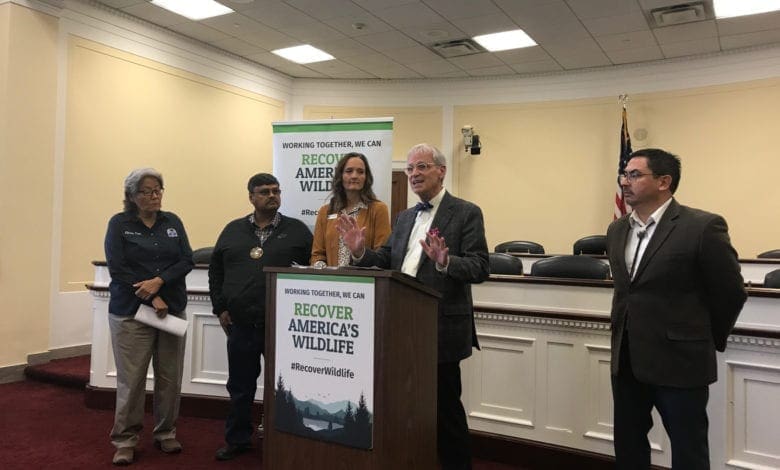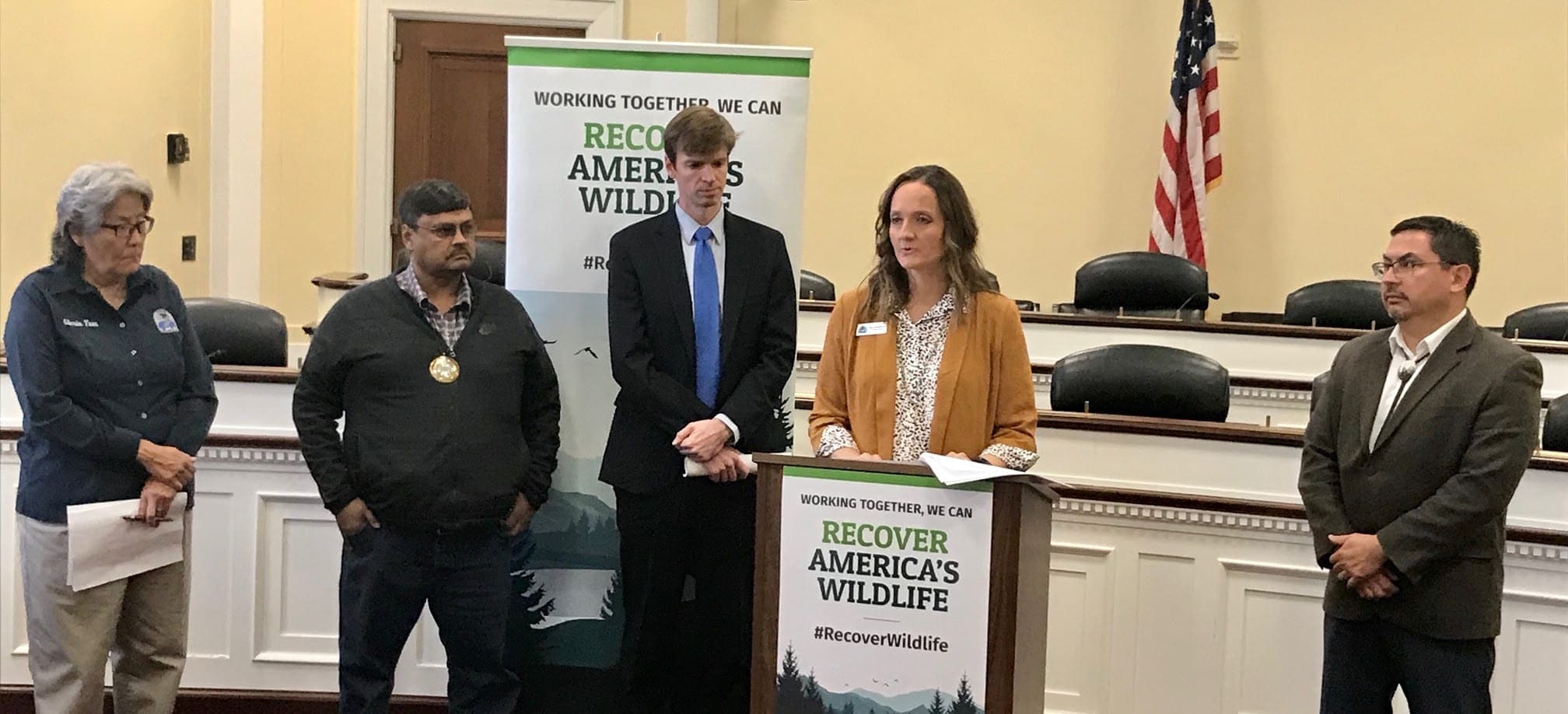Native American Leaders Urge Congress to Pass Bipartisan Recovering America’s Wildlife Act

WASHINGTON, D.C. (November 13, 2019) — Representatives from tribal nations urged Congress today to support tribal wildlife conservation by passing the bipartisan Recovering America’s Wildlife Act. Representatives from the Native American Fish and Wildlife Society, Eastern Band Cherokee Indians, Lower Brule Sioux Tribe, Confederated Salish and Kootenai Tribes, Northwest Indian Fisheries Commission and Navajo Nation Department of Fish and Wildlife highlighted in meetings with members of Congress and in a press conference on Capitol Hill how the bill would invest $97.5 million in tribal-led wildlife conservation efforts.
The Recovering America’s Wildlife Act, which has more than 150 bipartisan co-sponsors, would accelerate efforts to reverse America’s wildlife crisis and recover 12,000 species considered in need, including the more than 1,600 U.S. species listed under the Endangered Species Act. The bill would direct $1.3 billion to states in addition to is investments tribal-led wildlife conservation.
“There is a history of inequitable funding for tribal wildlife conservation efforts.” “But that is the past, and we are focusing on the present and future. The Recovering America’s Wildlife Act would provide $97.5 million per year for tribes to protect wildlife. The future of wildlife on tribal lands, and all lands, relies on this proactive approach to conservation.” –Elveda Martinez, president, the Native American Fish and Wildlife Society
“Tribal leadership is critical to conserving fish and wildlife species throughout the country. We have worked to leverage very limited resources to successfully protect and restore native species on Eastern Band of Cherokee Indian lands. These include ESA listed species, such as the northern long-eared bat, and animals like the eastern elk and the sicklefin redhorse fish that are tied to the local economy and Cherokee culture. Recovering America’s Wildlife Act will tremendously boost our program’s conservation abilities, while also helping to ensure that the ecological foundations of Cherokee identity are sustained for future generations.” –Mike LaVoie, natural resources manager, Eastern Band of Cherokee Indians
“Our Tribe recently developed an ambitious conservation plan and identified strategies and goals for key wildlife species and habitats but costs to implement the plan exceed existing funding sources. The Recovering America’s Wildlife Act would help us implement the activities that we feel are necessary to conserve wildlife and habitats that are of greatest conservation need to the Tribe. Moreover it would help our Tribe increase our level of law enforcement, which is the foundation of wildlife conservation.” –Boyd Grouneau, chairman, Lower Brule Sioux Tribe
“Our need is great to build resilience in our wildlife populations and to restore lost or diminished wildlife for the diversity required to face climate change and human growth. We have been creative today with management but tomorrow’s future will need an effort well beyond what our current management funding can provide, it will need Recovering America’s Wildlife Act. ” –Fred Matt, council member, Confederated Salish and Kootenai Tribes
“Recovering America’s Wildlife Act is landmark legislation not only for states and tribes, but for all entities who are conserving and managing wildlife. We all know wildlife know no boundaries and they obviously don’t recognize different jurisdictions. Recovering America’s Wildlife Act is our best attempt to bring funding across to these different jurisdictions in an effort to get ahead of our declining wildlife “populations, in a time where there are so many influences impacting our natural environment. The Tribal Title brings tribes to the forefront in conservation, alongside state game and fish agencies and federal entities. We need to communicate with each other and we need to collaborate if we are going to reverse the trend.” –Gloria Tom, director, Navajo Nation Department of Fish and Wildlife
“The Northwest Indian Fisheries Commission, comprised of 20 treaty tribes in western Washington, proactively co-manage fish and wildlife with the State of Washington. Through the tribes’ management efforts, we’ve been able to restore elk populations and prevent extinction of salmon stocks, all while continuing to carry out our way of life. But management is costly for tribes and that’s why Recovering Americas’ Wildlife Act is one of the most significant wildlife conservation bills in decades. It provides tribes with much needed, long-term, stable funding to protect and conserve species.” –Justin Parker, executive director, Northwest Indian Fisheries Commission
Despite a long history of under-funding and exclusion from federal funding opportunities, Tribal nations have some of the most successful and innovative natural resource programs in the country. Tribes manage or influence the management of tens of millions of acres of land. These lands provide vital habitat for more than 525 federally listed threatened and endangered plants and animals, many of which are both biologically and culturally significant to Tribes.

The Recovering America’s Wildlife Act will help Tribes:
- Manage wildlife and habitat on their lands as well as collaborate across jurisdictions to protect migrating wildlife.
- Assist in the recovery of threatened and endangered species.
- Manage, control and prevent invasive species and diseases.
- Ensure that tribes have the staff capacity to do all they can to protect wildlife.
There are countless stories that exemplify excellent Tribal fish and wildlife resource management. This history of success would be sustained, strengthened and expanded with an investment of resources from the Recovering America’s Wildlife Act. The bill would help remedy past inequity in conservation funding for Tribes and pave the way in recovering and protecting America’s wildlife.
Visit the National Wildlife Federation Media Center at NWF.org/News.
